Note
Access to this page requires authorization. You can try signing in or changing directories.
Access to this page requires authorization. You can try changing directories.
APPLIES TO:  2013
2013  2016
2016  2019
2019  Subscription Edition
Subscription Edition  SharePoint in Microsoft 365
SharePoint in Microsoft 365
Note
Many of the features described in this series are also available for most sites in SharePoint in Microsoft 365.
Quick Overview
Stage 9: Configure the query in a Content Search Web Part on a category page in SharePoint Server explains:
- How to add a Content Search Web Part to a page
- How to configure the query for a catalog page
The next step is to do the same for the catalog item page.
In this article, you'll learn:
Defining how catalog items should be displayed on our Contoso site
How to configure a query in a Content Search Web Part on a catalog item page
Start stage 10
Defining how catalog items should be displayed on our Contoso site
The various products featured in the Contoso catalog are all available in different colors. For example, by looking in our catalog list, you'll see that the Northwind Traders 50W Car Radio is available in five colors. The color versions of a product are grouped under a common Group Number.
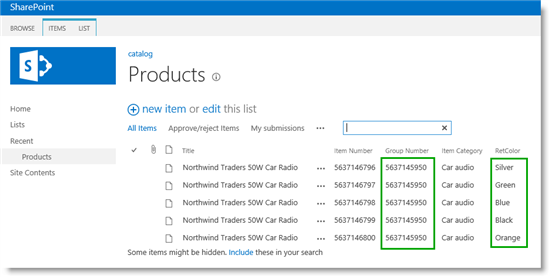
When displaying a product on our Contoso site, visitors should easily see that the product is available in other colors. For example, when visitors browse to a silver colored version of the Northwind Traders 50W Car Radio, they should easily see which other color options are available for that item. They should also be able to view details quickly about the product in another color, without having to go back to the category page.
So, on our catalog item page, we want to display items that have the same Group Number. To do this configuration, we must use the Content Search Web Part (CSWP).
Note
The item details page that was automatically created when we connected our publishing site to our catalog as described in Stage 5: Connect your publishing site to a catalog in SharePoint Server contained several Catalog Item Reuse Web Parts (CIRWP). There are scenarios where using CIRWPs to display item detail content would be appropriate. But, because the CIRWP is only able to display one item at a time, we can't use this Web Part for our Contoso scenario.
For info about how to customize the automatically created catalog item page using CIRWPs, see How to: Customize page layouts for a catalog-based site in SharePoint 2013.
How to add a Content Search Web Part to a catalog item page
Browse to the catalog item page. In our scenario, click the item "Northwind Traders 50W Car Radio" in the "Audio" category.
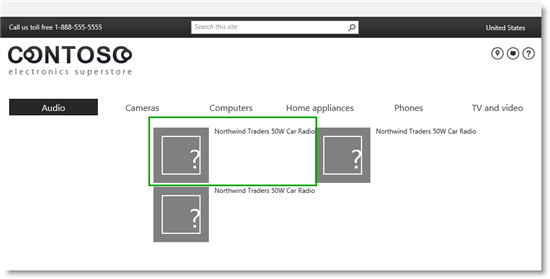
Because we didn't add any Web Parts to the page when we created it in Stage 7: Upload page layouts and create new pages in a publishing site in SharePoint Server, this page doesn't show any content.
Our catalog item page only has one Web Part zone. To add a CSWP to our catalog item page, repeat the steps from How to add a Content Search Web Part to a page and add the Web Part to Zone 1.

As was the case when we added a CSWP to our category page, the Web Part displays only content such as Audio, Cameras and Computers but not the content we want. To make the Web Part display Contoso catalog content, we must configure the query in the Web Part. To configure the query, we'll use what's known as a query variable. But first, let's take a look at what query variables are and how they're used when you configure a query.
About query variables
A query variable is a placeholder that is replaced with a value when a query is run. Let's look at this definition within the context of our Contoso scenario.
You might not have been aware of it, but in Stage 9: Configure the query in a Content Search Web Part on a category page in SharePoint Server, we used a query variable when we configured the query in the CSWP on the catalog page. When we selected Restrict by current and child navigation terms, a query variable was added to our query. That query variable was a placeholder for the navigation value in the URL such as audio, camera, or mp3. Whenever a visitor clicks a category, the query variable in the Web Part is replaced with the navigation value in the URL. As a result, the Web Part issued a query for catalog items that are tagged with "audio", "camera", "mp3", and so on.
Coming back to our catalog item page, we want to display items that have the same Group Number. Remember in Stage 3: How to enable a list as a catalog in SharePoint Server how we added Group Number as one of the list columns to be used as a Catalog Item URL Field. We did this configuration so the value of Group Number would be used in the URL.
The following screenshot shows our final Contoso site. Notice that the group number, 5637145950, is used as the second to last value in the URL.
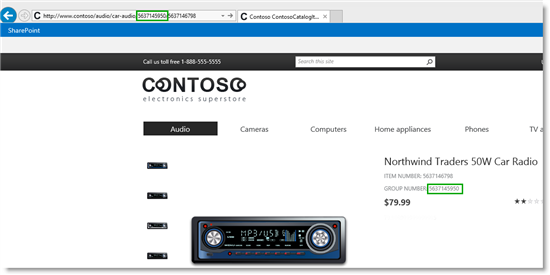
If we browse to another product, we'll see the group number for this product (5637145875, for example) is also used as the second to last value in the URL.
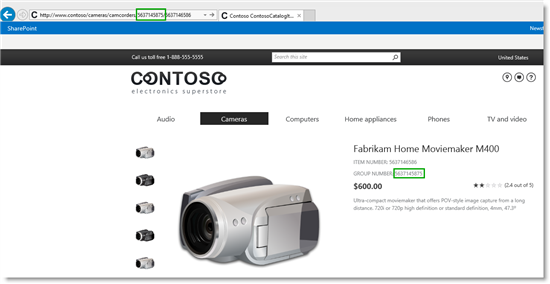
So, when you configure the query for the CSWP on our catalog item page, you should use a query variable that will represent the second to last value in the URL.
Query variables are contained enclosed in braces as follows: {QueryVariable}. Don't worry about those braces, this syntax isn't as scary or as complex as it might look.
As mentioned above, when we configured the query in the CSWP on the catalog page we used a query variable. But we didn't have to deal with any scary looking braces because the nice looking radio button, Restrict by current and child navigation terms, took care of it for us. To configure the query for our item catalog page, we must add a query variable with braces. Luckily, we'll have some friendly pull-down menus to help us along. So let's delve into the task of configuring the query.
How to configure a query in a Content Search Web Part on a catalog item page
In the Web Part, select the Web Part menu > Edit Web Part.
In the Web Part tool pane, select Change query. This option opens a dialog box.
In the dialog box, from the Select a query list, select your catalog result source. In our scenario, it's catalog - Products Results.

Select Switch to Advanced Mode.

In Advanced Mode, in the Query text field, you'll see some text. This text is the query text that represents our result source catalog - Products Results. (We saw the same query text in Stage 9, when we looked at How to view details of the query configuration.)
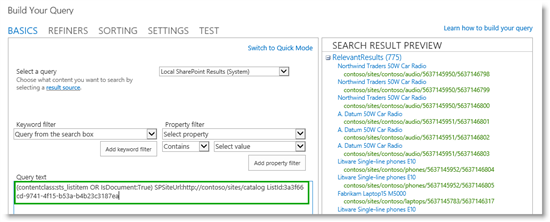
In the Property filter list, select Show all managed properties.
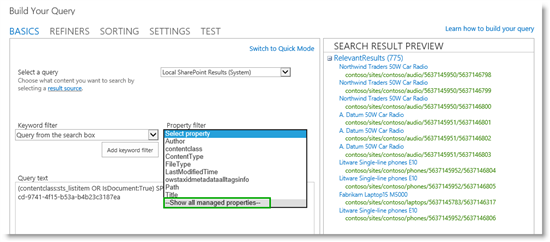
In the Property filter list, select ProductCatalogGroupNumberOWSTEXT, Contains, and Value of a token from URL.
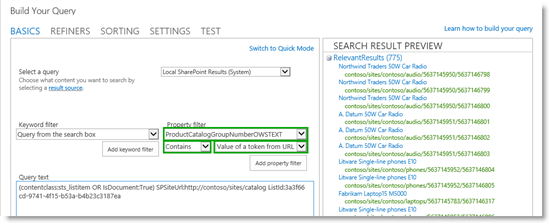
ProductCatalogGroupNumberOWSTEXT is the managed property name of the site column Group Number. (Earlier in this series, we looked at naming convention for this column in Naming convention for the default site columns in the Products list.) Selecting Contains and Value of a token from URL will create the query variable we want to use.
Select Add property filter.
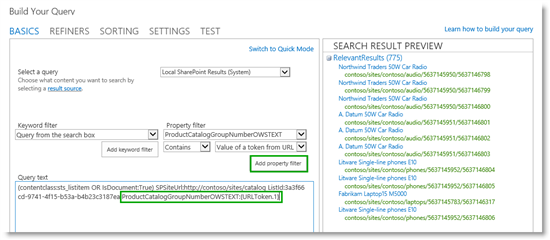
Notice that ProductCatalogGroupNumberOWSTEXT:{URLToken.1} is added to the Query text field. So without having to know about query syntax or type a curly bracket, we have added a query variable.
So now you might be thinking "OK, that was easy, but what does ProductCatalogGroupNumberOWSTEXT:{URLToken.1} actually mean?" Let's break it down:
ProductCatalogGroupNumberOWSTEXT is the managed property that represents the Group Number column in our catalog.
The colon : means "contains"
{URLToken.1} represents a value from the URL of the current page. The integer, in this case 1, represents the value in the URL as counted from right to left. So, for example, in the URL
https://www.contoso.com/cameras/camcorders/563714875/6637146586, the query variable {URLToken.1} represents the value 6637146586.If we put the complete query together, it means:
From the result source catalog - Products Results, search for items where the value of the managed property ProductCatalogGroupNumberOWSTEXT contains the value that is currently used as the first value in the URL, counting from right to left.
In the last step of the procedure in Stage 3: How to enable a list as a catalog in SharePoint Server, we defined that the item URL should contain both Group Number and Item Number as catalog Item and URL fields. This means that the first value in the URL, counting from right to left, is Item Number. We want to search for items that have the same Group Number. Therefore, we must make a small change to the query variable.
In the Query text field, change the number in the query variable to 2.

Now, the query in the Web Part will search for items whose ProductCatalogGroupNumberOWSTEXT value is the one currently used as the second value in the URL, counting from right to left.
To test that this query returns the correct results, select Test query.
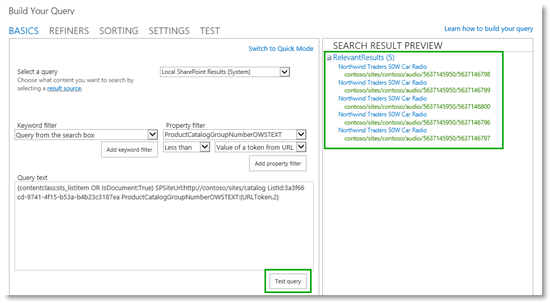
Notice that five items are displayed under RelevantResults. This result verifies that the query is correct, because we know that the Northwind Traders 50W Car Radio is available in five colors.
Select OK and save the page.

Even though three products are displayed instead of one, and we still don't have the Contoso look, this result denotes progress. The query in the Web Part is now configured. In the next article we'll show you how to add display templates that will give our items the Contoso look.
Next article in this series
Stage 11: Upload and apply display templates to the Content Search Web Part in SharePoint Server